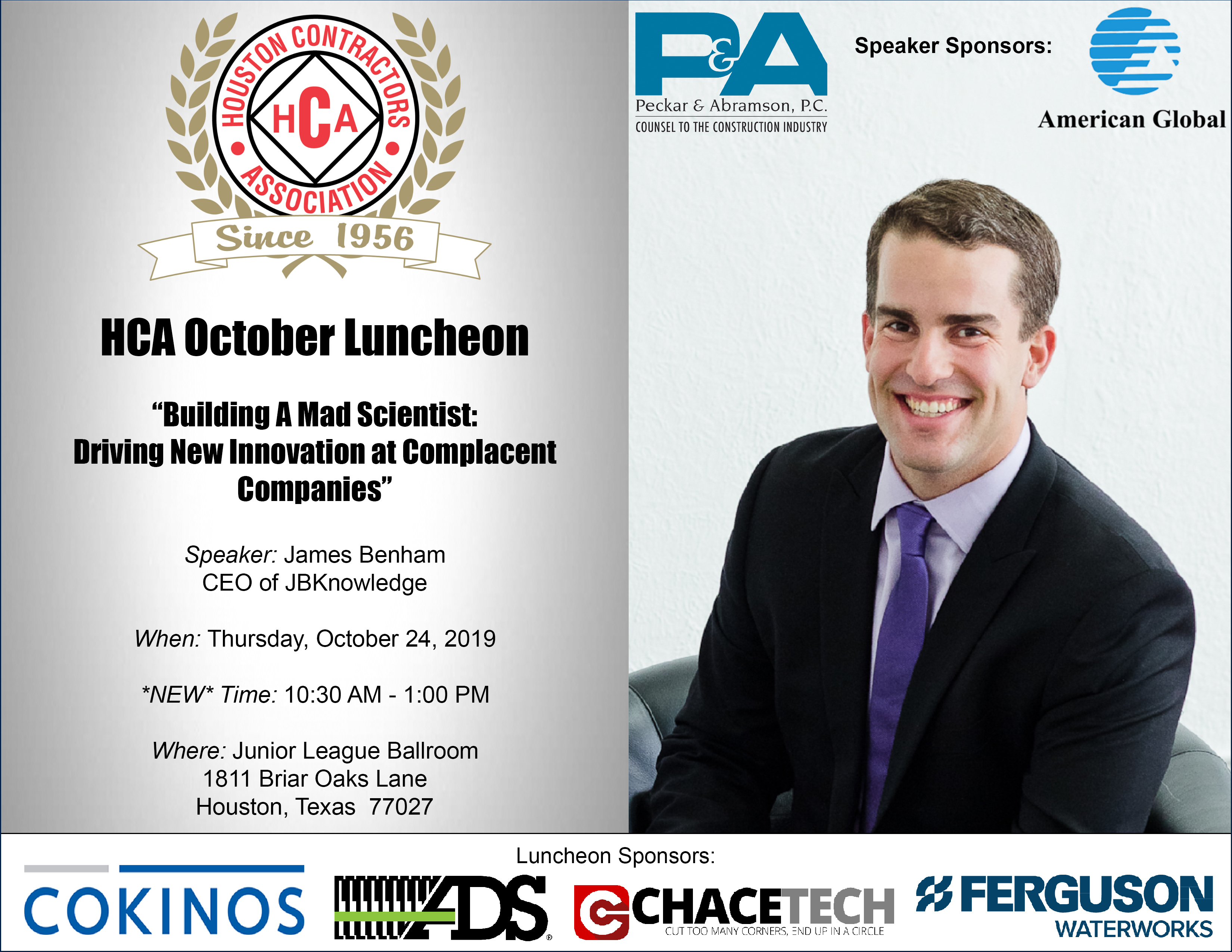HCA MEMBERS ARE CHALLENGED TO BECOME MAD SCIENTISTS
Tuesday, April 7, 2020
HCA MEMBERS ARE CHALLENGED TO BECOME MAD SCIENTISTS

“Construction is the most important industry on the planet,” said James Benham, CEO of JBKnowledge, host of The ConTechCrew podcast, professional speaker, and the Houston Contractors Association’s October 2019 luncheon presenter. Having the Houston Junior League ballroom full of representatives from companies in Houston’s civil construction industry, this statement was well received. Benham’s presentation, Building a Mad Scientist: Driving New Innovation at Complacent Companies, challenged the HCA members to break from “the way it’s always been done” and be their company’s innovative Mad Scientists who chase innovation, target inefficiencies, and achieve their audacious goals.
With the logos of failed companies projected on the screen behind him, Benham warned of disregarding disruptive innovations. Derived from the term “creative destruction,” disruptive innovation is defined as the process in which new technologies or new kinds of products invalidate their predecessors while creating new enterprises. “The future is already here—it’s just not evenly distributed,” quoted Benham. Innovation is happening, the results are just not yet the industry standard. He covered notable cases of failed businesses – Blockbuster, Polaroid, Tower Records – and the reasoning for their downfalls. Although this process is a necessary element of capitalism, how a company responds to disruptive innovations can be a litmus test for its success or collapse. Benham told the crowd that in order to future-proof their companies and avoid business failure, they must become Mad Scientists.
What is a Mad Scientist? Benham argued that this is someone who is an “unabashed, unashamed capitalist” who fights complacency, targets inefficiency, and is relentless in driving innovation at their company. They drive innovation to be the disrupter, not the disrupted. Benham then posed the question, “How do you build a Mad Scientist?” He stated that there are five key steps to do so.
Have an audacious goal. Expanding upon the S.M.A.R.T. goal criteria of being specific, measurable, achievable, relevant, and time-based, a particularly audacious goal will incite a bit of fear within a company. Paradoxically, the element of achievability should be challenged. This will require the company leadership to present the goal to the rest of the organization in an inspiring matter to ignite an internal motivating energy. This will foster an entrepreneurial spirit and force an innovative company culture to achieve the unachievable. Benham used the example of Faith Technologies who targeted labor inefficiencies to increase productivity. Their audacious goal was to have all jobsite tools and materials within 30 feet or 30 seconds from a worker. They achieved this and took their 39% productivity rate to 64% within a year. They are now continuing to “Strive for Five” by having their materials within five feet or five seconds from their workers.
Have dedicated staff and budgets. Benham argued that innovation does not occur in employees’ spare time. “When you ask someone to complete a task as an ‘also job,’ you will get ‘also results.’” Benham advised the HCA members to create an innovation team within their company. The sole job of this team should be to innovate, he said. If a company is intentional about it, innovation will happen far more often. Benham stated that contractors spend on average one percent of their annual revenue on technology. This is the least amount spent of any other industry. Most construction companies have the funds for innovation, said Benham, but chose to not spend it. He urged the audience to be intentional and dedicate the resources necessary for innovation. Complacency kills.
Have a process. Benham stated that the key differentiator between companies is their process.
He said that the method that works for JBKnowledge is EOS, the Entrepreneurial Operating System. Once discovered and put into effect, Benham stated that this process fixed his company’s meetings. Now, his meetings are timed, have a specific agenda, and have strict meeting rules. Benham stated that electronics are not allowed in his company’s meetings. All electronics are left at the door. He stated that to be an innovator, to be a disrupter, you have to focus with your team. “Treat your meetings like a team huddle. You should look forward to your meetings.” He stated that one of the top causes of failure at innovation companies is having bad meetings.
Spend time studying the problem. Benham stated that if a company has a problem, 55 minutes should be spent studying it and 5 minutes spent solving it. He again advised to create an innovation team— a group of employees that learns to study problems and identify waste. “Technology and innovation go hand-in-hand with lean.” He recommended the book 2 Second Lean by Paul Akers and joked that “lean starts in the bathroom.” He told the audience, the next time they are in the restroom, to notice where the trash was in relation to the towel dispenser. “If the trashcan is not right under the towels, then you have a lean problem.” He gave the example of how a company targeted their lean strategically placed the bathroom area on their job site. This saved the workers hundreds of man-hours and miles walked to and from the bathroom area annually.
Focus on adoption. Mad Scientists are industry leaders, big thinkers, and true visionaries. They can be the creator of the innovation or one who recognizes the value in another’s. If the latter, it is their responsibility to convince their company to adopt the innovation. Benham stated that he sees company executives that are inspired by his presentations and introduce new technology to their company without a plan. “You have to take the time to sell them. You have to win hearts and minds,” said Benham.
In closing, Benham encouraged the audience to listen to his weekly podcast The ConTechCrew to stay up-to-date on global news and current trends within the construction and technology industries. The world is full of Mad Scientists.
###
|